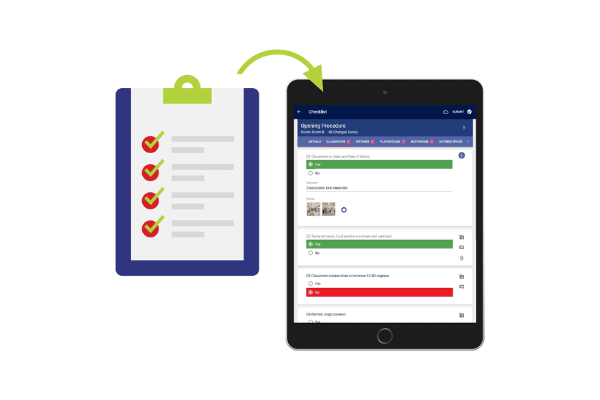
If ever-growing pile of paper forms in your early childhood centre has finally gotten the better of you, congratulations! Recognising there must be a better way to stay on top of compliance is the first step on your journey to better compliance management.
Online compliance management tools will not only make life easier for you and your staff, they turn each and every task into usable data to give you more visibility than paper possibly can.
So how do you move from paper pushing to real-time compliance tracking?
Having helped many leading ECE organisations successfully make the switch to our child care software, we’ve compiled a few tips to help you get started:
1. Group recurring tasks
Digitizing a paper document to an online compliance tracker is not as simple as copying over information from an existing checklist, it’s taking the time to review your processes in order to streamline them.
Most paper checklists are a long list of ‘to dos’ so begin by looking at the tasks being completed by your educators and directors and group them together as frequency-based checklists; daily, weekly, monthly, bi-monthly etc.
The newly-grouped checklists should reflect the pillars of your internal audit requirements (such as daily open and close procedures, cleaning schedules, excursion checks) as well as state or regulatory authority requirements (such as food safety and environment checks to meet environmental health and safety (EHS) standards).

2. Evaluate and review
Next, evaluate whether there’s any duplication across these checklists. If there is, consolidate.
Pay attention to each required task, ask yourself ‘Why would I do this?’ and consider whether it meets the need and desired outcome. Is it more arduous than it should be or does the question gloss over important details?
Taking the time to review your questions in this way has two main benefits;
It gives you visibility on processes that are working well and those that require review so you can systematically improve your training procedures and, ultimately, your overall compliance.
It identifies areas where additional ‘help’ could be embedded in the digital document. This provides instant support for users as they complete the checklist so they can make the right decisions, first time, no matter how experienced they are using the child care software.
3. Score and benchmark
Once your checklists have been evaluated, going digital enables you to assign scores so you can create best-practice benchmarks.
Scoring gives you the ability to track trends and performance, and set clear pass or fail benchmarks so you have instant visibility on areas that require additional support.
Kerran Menzies, Head of Client Services at 1Place, says scoring begins by working through the critical questions.
“We create mandatory fields for all non-negotiable questions, comments or photos to ensure all pertinent information is gathered in 1Place,” she says.
Next, Kerran works with the client on scoring.
“I tend to up-weight the positive answers and make deductions if non-negotiable answers are failed.”
4. Think about next steps
Another benefit of online compliance software is its ability to evolve and adapt to your organisation’s specific needs, be it at a centre level or the group as a whole.
As your educators complete their daily or weekly checklists they also can raise actions if issues are identified. These could be facility issues, training requirements or hazards they have noticed.
Adding hazard and property maintenance identification into daily checklists allows you take a systematic and efficient approach to compliance, freeing up your staff to focus on delivering an exceptional learning experience.



